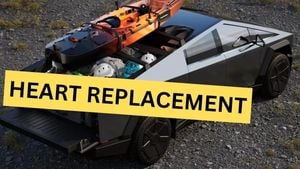Across the barren expanses of the Atacama Desert, scientists have made groundbreaking discoveries about life flourishing in environments long thought impossible for existence. Characterized by its extreme aridity, the Atacama Desert stretches along the Pacific coast of Chile and ranks as one of the driest places on Earth. Yet, researchers recently unearthed vibrant microbial communities thriving within its sun-scorched soils, showcasing nature's resilience against harsh conditions.
The key to unraveling this mystery lies within innovative research spearheaded by Dirk Wagner, Ph.D., from the GFZ German Research Centre for Geosciences, along with an international team of experts. Their study, published this month in the journal Applied and Environmental Microbiology, introduced a novel technique capable of distinguishing between extracellular DNA (eDNA), which originates from deceased cells, and intracellular DNA (iDNA), stemming from living organisms.
This development addresses significant challenges posed by traditional DNA extraction methods, which often fail to differentiate between active and dormant microorganisms. According to Wagner, traditional approaches typically yield mixed DNA samples from both living and dead organisms, complicative efforts to accurately assess microbial life. Wagner notes, "If you extract all the DNA, you have DNA from living organisms and also DNA from organisms which just died or perhaps have been dead for ages." With no prior methods effectively untangling intertwined genetic material, scientists struggled to grasp the dynamics of low-biomass communities.
To forge new paths, the team employed their separation technique on soil samples taken along varying moisture gradients from the Atacama Desert, ranging from coastal sand to the foothills of the Andes Mountains. This labor-intensive process involved multiple gentle rinsing cycles to sift out intact cells, ensuring success was achieved after four repetitions.
The analysis revealed astounding results, showcasing vivid microbial activity even under the driest conditions. Numerous samples indicated high occurrences of Actinobacteria and Proteobacteria across various depths—particularly within samples collected from the top five centimeters of soil, where Chloroflexota displayed dominance, embodying the community’s most active inhabitants.
Wagner marvels at the discovery, stating, "Microbes are the pioneers colonizing this kind of environment and preparing the ground for the next succession of life," emphasizing their role as foundational life forms capable of transforming barren terrains. The discoveries raise intriguing questions about the adaptability and function of microbial life, with Wagner noting these processes could also apply to recovery scenarios such as areas impacted by landslides or earthquakes.
This research not only illuminates life surviving under extreme circumstances but also serves as groundwork for broader applications. The methods devised have expansive potential, possibly aiding explorations of life on other planets, where conditions could mirror those of the Atacama.
The study has sparked interest beyond the scientific community, as it showcases microbial diversity and resilience where one might least expect it. Wagner and his team strategize to expand their findings through additional metagenomic sequencing of iDNA samples, which they believe will unearth even more complex insights about microbial ecosystems flourishing under dire conditions.
Overall, this impressive endeavor extends far beyond the Atacama Desert itself. The insights gained may fundamentally change our perspectives on where and how life can exist, challenging traditional ideas about natural habitats. Elizabeth Shankland, another researcher involved, highlights the importance of such findings, declaring, "By studying iDNA, we can gain substantial insights concerning the active segment of these communities." Such work not only enriches our comprehension of microbial adaptations but could redefine explorations of extraterrestrial life.



